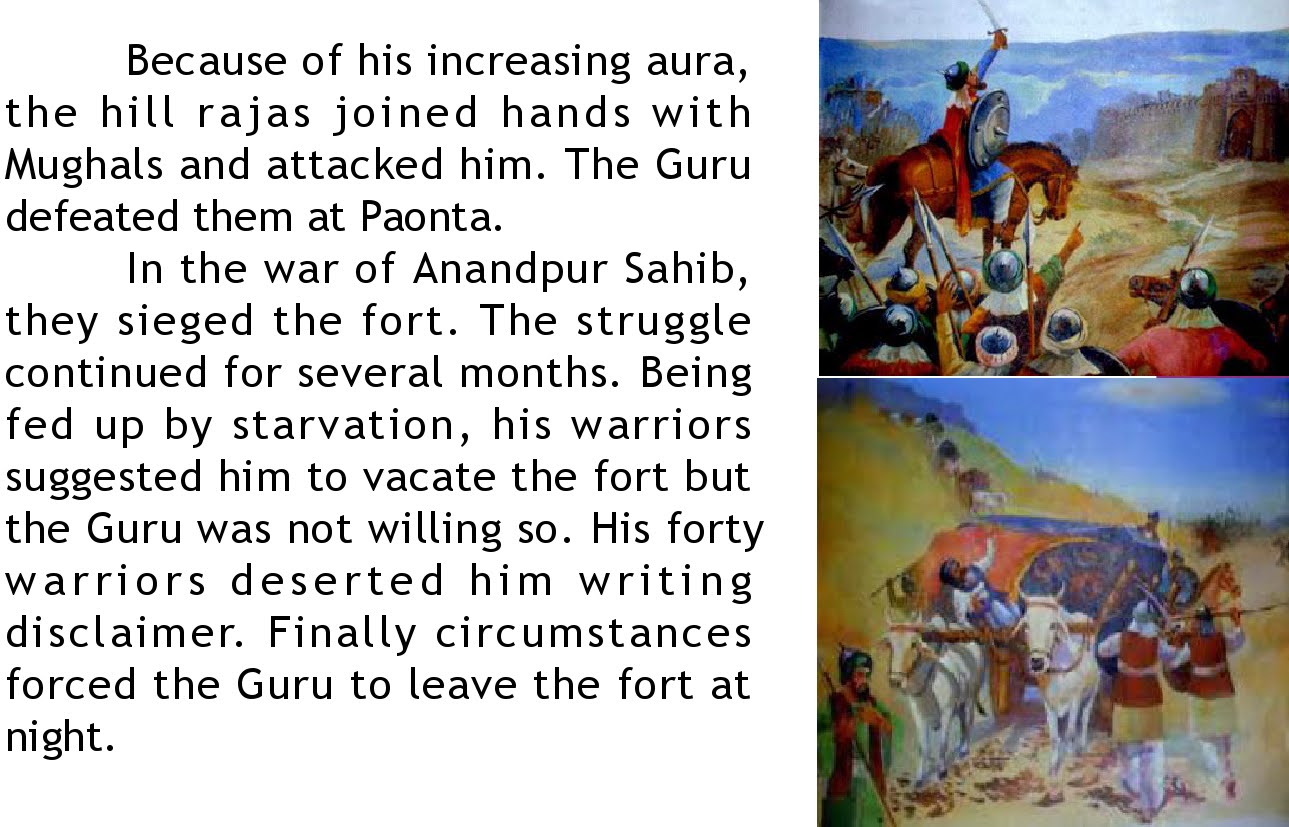Guru Gobind Singh
Glossary
1.
Contemplation: Act of thinking deeply
2.
Tyranny: Cruel and Unfair use of power.
3.
Penitence: repentance.
4.
Vehemently: in a forceful manner.
5.
Felicitations: Good wishes
6.
Self-abnegating: denial of oneself.
7.
Ordeal: Difficult experience.
8.
Torment: Great pain
9.
Numb: not able to feel anything.
10.
Subdue: depressed.
11.
Undaunted: determined despite difficulties.
12.
Disclaimer: a statement that denies responsibilities.
13.
Reverence: a feeling of great respect.
Very Short Question Answer
Q.1. Was the Guru born in Punjab or
somewhere else?
Ans.
He was born in Bihar.
Q.2. Name his father?
Ans.
Sri Guru Teg Bahdur.
Q.3. When did he create Khalsa?
Ans.
On the day of Baisakhi, in 1699.
Q.4. Whom did he write Zafarnama?
Ans.
To Mughal Emperor Aurangzeb.
Q.5. What offerings did prefer to
receive?
Ans.
Arms and horses.
Q.6. What did Masand do for which they
were called and punished?
Ans.
They did not pass the offering to Guru. Q.7. How did the hill rajas feel about
the Guru.
Summary Of The Chapter
Guru
Gobind Singh, the tenth Sikh Guru, was born in 1666 at Patna (Bihar) when his
father Guru Teg Bahadur was traveling in eastern India. The news of his birth
spread quickly and Muslim saint Syed Bhikhan Shah came to meet with two earthen
vessels. When newly born Guru touched both vessels, Syed predicted that this
child would treat Hindus and Muslims alike.
He
spent first five years of his childhood at Patna, then brought to Anandpur
Sahib town built by his father (on the foothills of Himalyas). At seven, his
schooling was started. He learnt Sanskrit, Hindi and Persian. At the tender age
of nine, he inspired his father for self-sacrifice to save Kashmiri Pandits.
His father placed him on his position and left for Delhi. He took the
responsibility and started fulfilling the mission of first Guru. He performed
his own devotions, held gatherings to teach religion. He asked his followers to
bring arms and horses as offerings to set up his own military force.
The
hill Rajas got afraid and thought that Guru wanted to establish his on empire.
They were also jealous of his magnificent court. They disapproved the practice
of ‘Langar’ (community Kitchen) too, where all dine together without any
discrimination.
On
the day of Baisakhi in 1699, among the large gathering of his followers, he performed
the ‘Creation of Khalsa’. Five persons
Daya
Ram, Dharam Dass, Muhkam Chand, Himmat Rai and Sahib Chand from different
Castes were baptised with nectar or Amrit (sacred water from iron vessel which
was stirred with two-edged sword while sacred verses were recited over it).
These five persons were called ‘Panj Pyare’ and given appellations of ‘Singh’
and asked to wear long hair, a comb, a steel bracelet, a short drawer and a sword.
Later Guru himself baptized from these five beloved ones, first full-fledged
members of Khalsa.
After
the creation of Khalsa the Guru decided to abolish the priestly order of Sikh
missionaries known as masand. Since they became corrupt, the Guru called and punished
them. These massand took offerings from Sikhs but never passed them to Guru.
Because
of his increasing aura, the hill rajas joined hands with Mughals and attacked
him. The Guru defeated them at Paonta. In the war of Anandpur Sahib, they
sieged the fort. The struggle continued for several months. Being fed up by starvation,
his warriors suggested him to vacate the fort but the Guru was not willing so.
His forty warriors deserted him writing disclaimer. Finally circumstances forced
the Guru to leave the fort at night.
Mughal
forces kept following him. In the battle of Chamkaur, he lost his two elder
sons whereas his two younger sons were caught by Governor of Sirhind and
bricked alive in a wall. Even in these horrified situations, he remained
unshaken.
On
his way to Nander, he wrote ‘Zafarnama’ (Letter of Victory) to Mughal emperor
Aurangzeb from Dina (a Village in Bhatinda) explaining his mission and how hill
rajas forced the war on him.
At
Khidrana (now Muktsar in Punjab) he met with Mughal forces again. His forty
Sikhs from Malwa who deserted him, rejoined him, fought bravely and died. They
were blessed by the Guru as ‘Forty Muktas’.
He
travelled South to Nander. On the way, he was stabbed by an Afghan in 1708.
Emperor Bahadur Shah sent an expert surgeon for him. He got healed. But one day
while stretching a powerful bow, his wounds opened again and he passed away.











